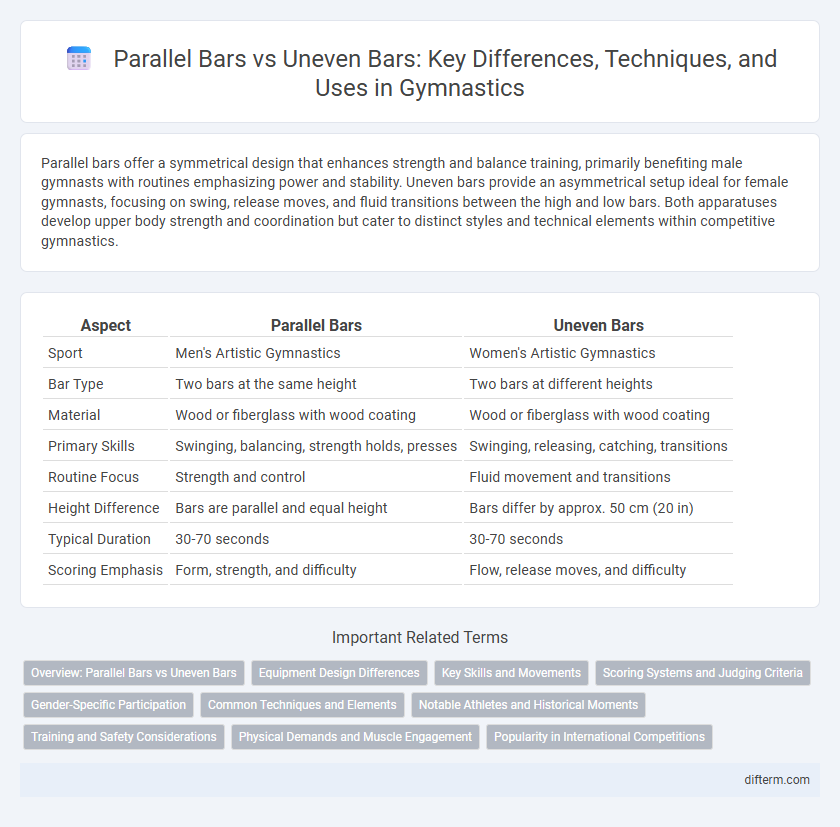Parallel bars offer a symmetrical design that enhances strength and balance training, primarily benefiting male gymnasts with routines emphasizing power and stability. Uneven bars provide an asymmetrical setup ideal for female gymnasts, focusing on swing, release moves, and fluid transitions between the high and low bars. Both apparatuses develop upper body strength and coordination but cater to distinct styles and technical elements within competitive gymnastics.
Table of Comparison
| Aspect | Parallel Bars | Uneven Bars |
|---|---|---|
| Sport | Men's Artistic Gymnastics | Women's Artistic Gymnastics |
| Bar Type | Two bars at the same height | Two bars at different heights |
| Material | Wood or fiberglass with wood coating | Wood or fiberglass with wood coating |
| Primary Skills | Swinging, balancing, strength holds, presses | Swinging, releasing, catching, transitions |
| Routine Focus | Strength and control | Fluid movement and transitions |
| Height Difference | Bars are parallel and equal height | Bars differ by approx. 50 cm (20 in) |
| Typical Duration | 30-70 seconds | 30-70 seconds |
| Scoring Emphasis | Form, strength, and difficulty | Flow, release moves, and difficulty |
Overview: Parallel Bars vs Uneven Bars
Parallel bars, primarily used in men's artistic gymnastics, consist of two horizontal bars set at the same height, emphasizing strength, balance, and swing elements. Uneven bars, featured in women's artistic gymnastics, have two bars set at different heights, facilitating dynamic transitions, releases, and grip changes to showcase fluidity and agility. Both apparatuses require distinct techniques and skills, highlighting unique aspects of gymnastics performance and athlete specialization.
Equipment Design Differences
Parallel bars consist of two horizontal bars set at equal height and spaced apart to accommodate a gymnast's hand placement during swings and releases. Uneven bars feature two bars at different heights, designed to challenge gymnasts with transitions and dynamic moves between the low and high bars. The design differences influence grip techniques, routine composition, and apparatus-specific skill execution in men's and women's artistic gymnastics.
Key Skills and Movements
Parallel bars require upper body strength, balance, and precise hand placements to execute swings, presses, and flight elements smoothly, emphasizing control and momentum. Uneven bars demand exceptional grip strength, body coordination, and timing for seamless transitions, release moves, and high-flying catches between the low and high bars. Mastery in both apparatuses enhances a gymnast's aerial awareness, core stability, and dynamic power application.
Scoring Systems and Judging Criteria
In gymnastics, scoring systems for parallel bars and uneven bars emphasize execution, difficulty, and composition requirements tailored to each apparatus. Judges award points based on the precision of swings, transitions, and holds on parallel bars, while uneven bars routines are scored with a focus on flight elements, release moves, and bar changes. The Code of Points guides deductions for form breaks, amplitude, and rhythm variations, ensuring fair evaluation across both men's parallel bars and women's uneven bars events.
Gender-Specific Participation
Parallel bars are predominantly used in male gymnastics events, emphasizing upper body strength and stability, while uneven bars are a staple in female gymnastics, showcasing agility and fluid transitions. The design differences cater to distinct skill sets, with parallel bars featuring two bars at the same height and uneven bars having one higher than the other. These apparatuses highlight gender-specific training regimens and competitive routines in artistic gymnastics.
Common Techniques and Elements
Parallel bars in men's gymnastics emphasize swings, transfers, and holds such as the giant swing, peach to handstand, and Maltese cross, showcasing strength and control. Uneven bars in women's gymnastics feature transitional skills like pirouettes, releases, and dismounts, including moves such as the Pak salto and Jaeger release that highlight fluid motion and precision. Both apparatuses require mastery of grip changes, body alignment, and timed swings to execute complex routines effectively.
Notable Athletes and Historical Moments
Parallel bars showcase legendary athletes like Vitaly Scherbo, whose innovative routines redefined the apparatus during the 1992 Olympics, while uneven bars highlight the groundbreaking performances of Simone Biles, whose record-breaking difficulty and fluid transitions revolutionized women's gymnastics. Historical milestones on parallel bars include the introduction of the double salto and intricate swing elements, contrasted with uneven bars' evolution from simple hand placements to high-flying release moves and complex pirouettes symbolizing the sport's advancement. The distinct progression of both apparatuses reflects shifts in training techniques, athlete specialization, and judging criteria, marking pivotal chapters in gymnastics history.
Training and Safety Considerations
Training on parallel bars emphasizes developing upper body strength and coordination through controlled swinging and balancing exercises, while uneven bars require mastering dynamic transitions and precise timing between bars of different heights. Safety considerations for parallel bars include proper spotting and use of grip aids to prevent slips, whereas uneven bars demand rigorous warm-up routines and crash mat placement to minimize injury risk from high-impact dismounts. Both apparatuses benefit from progressively increased difficulty levels and expert supervision to ensure safe skill acquisition.
Physical Demands and Muscle Engagement
Parallel bars emphasize upper body strength and stability, engaging the shoulders, chest, triceps, and core muscles to perform swings and support holds. Uneven bars require dynamic coordination and timing, activating the lats, forearms, grip muscles, and core during transitions between bars at different heights. Both apparatuses demand significant muscular endurance, but uneven bars place higher stress on grip strength and explosive power for release moves.
Popularity in International Competitions
Parallel bars and uneven bars hold distinct places in international gymnastics competitions, with uneven bars featured prominently in women's artistic gymnastics and parallel bars exclusive to men's events. The uneven bars enjoy widespread popularity globally due to high-profile competitions like the Olympics and World Championships showcasing dynamic routines and release moves. Parallel bars maintain a strong following in men's gymnastics but generally attract less media attention and fan engagement compared to the visually complex uneven bars apparatus.
parallel bars vs uneven bars Infographic

 difterm.com
difterm.com